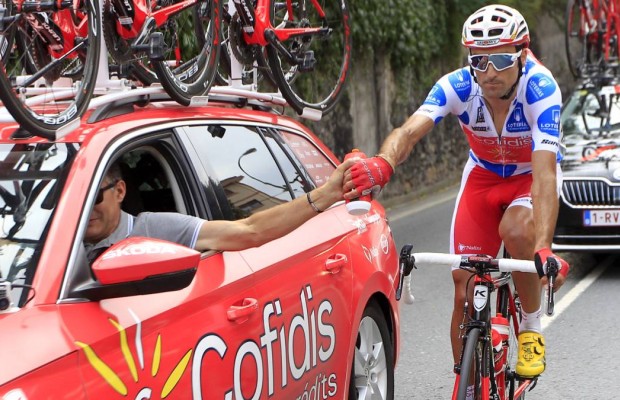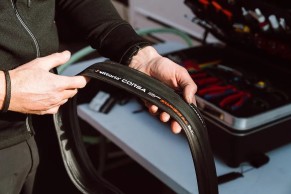Tyres in the Tour de France, the tubeless is already the reference
In recent years, tubeless tyres have monopolized the world of competition, achieving what seemed unthinkable, overtaking tubular tyres as the option chosen by professional cyclists as the system with the best rolling quality and grip capacity. But not only in the use of tubeless, but also in their sizes. Let's take a look at the tyres used in the 2023 Tour de France peloton.

Safety, grip and efficiency, these are the tyres used on the Tour de France bikes
When we review bicycle setups, tyres tend to be a component that is usually left in the background. It is clear that in cycling the choice of tyres does not have nearly the same importance as in sports that are contested to the tenth of a second such as motorcycling or Formula 1, however its role is relevant in the cyclist's performance.
Starting with rolling quality, i.e. offering the least resistance to rolling, a gain that is not as marginal as one might think, without prejudice to other qualities such as absorption or weight. Of course, cornering grip is also essential to cope with the difficult descents that cyclists encounter during the stages, especially on mountainous routes where it is essential that the tyres transmit full confidence, especially at the pace at which they usually descend in competition.
RECOMENDADO

How many calories are burned when cycling

What is heart rate variability and how does it affect the cyclist?

Change wheels if you want to transform your bike's behavior

What bike size do you need? Here's how to find out

How does age affect performance and recovery?

How long cyclists can be pushed when handed a sticky bottle?

As we said at the beginning, in recent years tubeless tyres have been gaining ground among the teams, banishing the classic tubular. Its rolling qualities are equal to or better than those of tubulars, and it is easier for mechanics to replace them. We are not going to deny it either, many wheelset brands have been opting for the development of carbon wheels for tubeless systems, abandoning the production of tubular models.
On the other hand, the tubular had the great advantage of allowing the professional to continue riding even in the event of a flat tyre by remaining attached to the rim.
In addition to the incorporation of tubeless tyres, what most attracts the attention of long-time cycling enthusiasts is the growth in the width of the tyre used. Long gone are the 80's when cyclists used 19 mm tubulars inflated to more than 10 bar pressure. Also completely banished is the 23 mm size, the most widely used for most of the 21st century. Today the standard in the peloton is 700x25c tubeless tyres.

However, this size is also starting to be phased out in favor of 700x28c. As we told you some time ago, a wider tyre transfers power to the road more effectively, with less rolling resistance. In fact, the only disadvantage of using wider tyres is the weight gain from mounting "more rubber".
However, another reason teams choose to use wide tyres is aerodynamics. With the tube profiles used in modern frames, taking advantage of the current UCI regulations, the tyres must also be wide in order to integrate into the lines of the rims and to correctly guide the airflow to the desired areas of the frame.
As we said before, the problem of using wider tyres is the weight increase that it entails. To put a stop to this, it has caught our attention that some of the teams that use Continental tyres such as INEOS Grenadiers or UAE Team Emirates have opted for the TT version of the GP5000 instead of the S that are usually mounted. The TT are designed to be used in time trials, but teams have found them to be reasonably reliable for use in in-line stages despite having less rubber and puncture protection than the conventional ones.

By the way, speaking of brands, it is curious to count the number of tyre suppliers present in this Tour de France. It's not surprising to see that Vittoria and Continental are the most numerous, each equipping 7 squads. Specialized follows, supplying the three teams that use their bikes: Soudal-QuickStep, Bora-Hansgrohe and Total-DirectEnergies. Pirelli is present on the bikes of AG2R-Citroën and Lidl-Trek. Finally, there are three other brands: Schwalbe, Maxxis and Cadex, the latter equipping the Giant bikes of Jayco-AlUla.
In any case, always riding top of the range models that are characterized by using compounds in which maximum grip is sought at the expense of prioritizing the durability of the tyres, something that the teams do not take into account since for them it is an element of wear that the mechanics check daily after the stages and replace when they observe the slightest cut.

Compounds that, contrary to what one might think, are the same for all stages, including rainy days, as they already offer maximum grip. What does vary when it rains are the pressures chosen by the riders, which are usually lowered a few tenths compared to what is usually used in order to gain a little more contact surface with the ground.
There is no doubt that, as with bikes, all the tyre development that brands carry out in competition, testing different casing and compound solutions, we can then enjoy them on our bikes, even extending the solutions tested in competition to the rest of the range.
The peloton's tyres
As we mentioned before, these are the reference tyres in the peloton, tyres that, like bikes and other components, are available in the catalogs of the different brands so that you too can enjoy the same rolling qualities, puncture resistance and grip that professional cyclists benefit from.
Vittoria Corsa
The Italian brand is one of the mythical firms in the world of cycling. They offer exquisite competition tyres under the evocative name of Corsa. These tyres start with an ultra-flexible 320 TPI cotton casing, i.e. with extremely fine threads and enormous density.

This makes possible a material that adapts to every slightest unevenness of the terrain as well as making possible a better transfer of force. These qualities are complemented by a tread in whose composition Vittoria adds graphene, in the central part of the tread, which reduces the resistance offered by the tyre while increasing resistance to punctures. They are available in sizes from 700x23c to 700x32c, with a weight of 255 g for the most common 700x25c version.
Continental GP5000 S TR
The German brand had in its GP4000 some of the most famous tyres on the market, praised by all who used them. The arrival of tubeless tyres led to the development of the new GP5000, which soon evolved into the S TR model, which was a few grams lighter than the original version. These tyres are practically indestructible, with a totally predictable and progressive grip and an excellent rolling. All this combined with an unusually long life for competition tyres.

These GP5000 S TR use the brand's proven Black Chili compound with which they seek, above all, the lowest rolling resistance, of course, without compromising their grip capacity. Continental offers these tyres in versions with black or cream sidewalls in sizes from 700x25c to 700x32.
Specialized S-Works Turbo
Morgan Hill's brand supports its excellent S-Works Turbo tyres on a 120 TPI cotton casing that seeks the best flexibility so that the tyre adapts in the best possible way to the road surface. These qualities are combined with its low rolling resistance T2 compound in the central part of the tyre, with the ultra-soft T5 rubber used on the sidewalls of the tyre to provide excellent cornering grip.

In addition, it does not renounce to an optimal puncture protection thanks to its Blackbelt band located under the tread, which in its latest version provides 8% more resistance to this incident than previous versions of these tyres. These tyres are fully compatible with hookless rims and are available in sizes 700x26c, weighing 260 g; 700x28c and 700x30c.
Pirelli P-Zero Race TLR
Of the multitude of options offered by the Milan-based company for its famous maximum performance tyres, these Race TLR tyres are perhaps the most common on team bikes thanks to their balance of qualities. They are only available in 26 and 28 sizes, the most racing options and, like other Pirelli tyres, rely on the great performance of their SmartEVO compound.

Regarding the casing, Pirelli uses a double layer of 120 TPI in order to combine optimal protection with great watertightness for tubeless use. These tyres weigh in at 245 g in the 26 g version, which is extremely competitive compared to its rivals.